31 Pygmy Marmoset Facts: Guide to Finger Monkeys (Cebuella pygmaea)
Are finger monkeys real? Yes they are! In this post, you’ll learn 31 pygmy marmoset facts with a focus on wild finger monkeys (that live in Ecuador). We also cover common questions about keeping finger monkeys as pets. Plus tons of photos and videos.
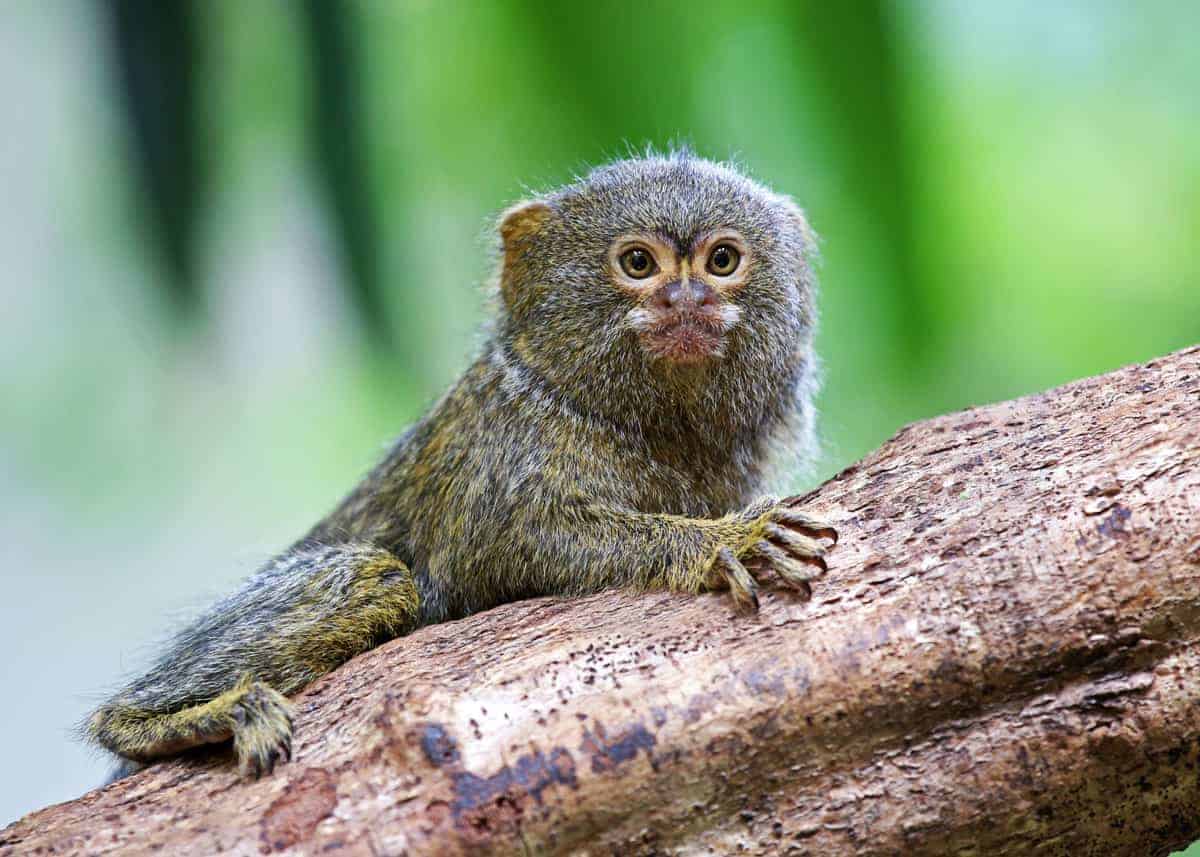
Travel tip: If you’re traveling to the Amazon basin (and want to see a pygmy marmoset) you should bring a camera with a decent zoom and a quality pair of binoculars.
31 Facts About Pygmy Marmosets
Pygmy marmosets have many different names. They also have many different eccentricities. Even though they’re some of the smallest primates in the world, they pack a lot of interesting habits in their pint-size bodies! If you’d like to learn more about these quirky, colorful creatures, here are 31 pygmy marmoset facts to get you started.
1. What is a pygmy marmoset?
Pygmy marmosets are tiny monkeys that come from South America. They’re frequently sold as pets, but there are also thriving populations in the wild.
They’re smart, curious and playful little creatures, so they’re always a treat to see when you’re in South America.
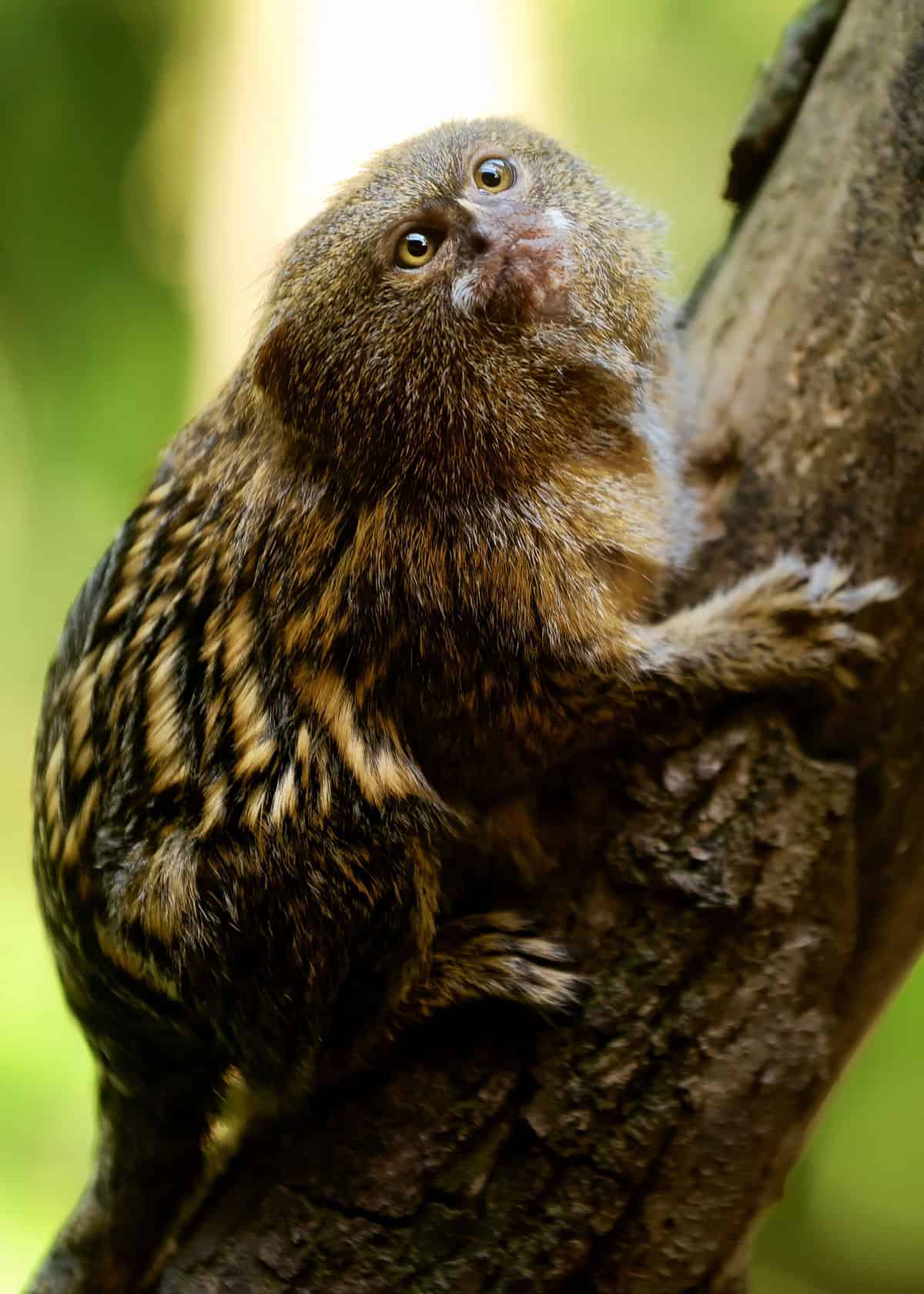
2. Are there any other names for pygmy marmosets?
The scientific name for a pygmy marmoset is cebuella pygmaea. You might also see its two sub-species referred to as cebuella pygmaea pygmaea and cebuella pygmaea niveiventris.
Conversationally, the pygmy marmoset is known as the “finger monkey.” This is because it’s so small that it can wrap around your finger with space left over. If you’re thinking of buying one as a pet, “finger monkey” is probably the term that the breeder will use. See more on finger monkeys as pets at the end of the post.
3. What is the pygmy marmoset called in other languages?
Most languages refer to the pygmy marmoset with some combination of the words “monkey,” “small,” “dwarf,” “cute” or “miniature.”
- Its French name is ouistiti mignon or “small/delicate marmoset.”
- Its Portuguese name is micoleãozinho or “little lion monkey.”
4. Why are pygmy marmosets called “New World” monkeys?
There are notable differences in monkeys that are native to North and South America (the “New World”) and ones that are native to Asia, Africa and Europe (the “Old World”). Not only do they have different sizes, diets, habitats and reproductive cycles, but they use their tails differently and have various degrees of opposable thumbs.
Pygmy marmosets are classified as New World monkeys because they’re native to South America and fit all of the requirements for the label.
5. How big are pygmy marmosets? How much do they weigh?
You might be wondering if finger monkeys are truly small enough to deserve all of the fuss. The answer is yes. They measure just 4 – 6 inches from head to hindquarters, and they weigh an average of 3.5 ounces.
They do get a little bigger when you factor in their tails. Measuring between 6 – 9 inches, these tails are longer than their entire bodies. Their tails aren’t prehensile, so they can’t be used to grip tree branches or rip open fruits. They’re mostly just for balance.
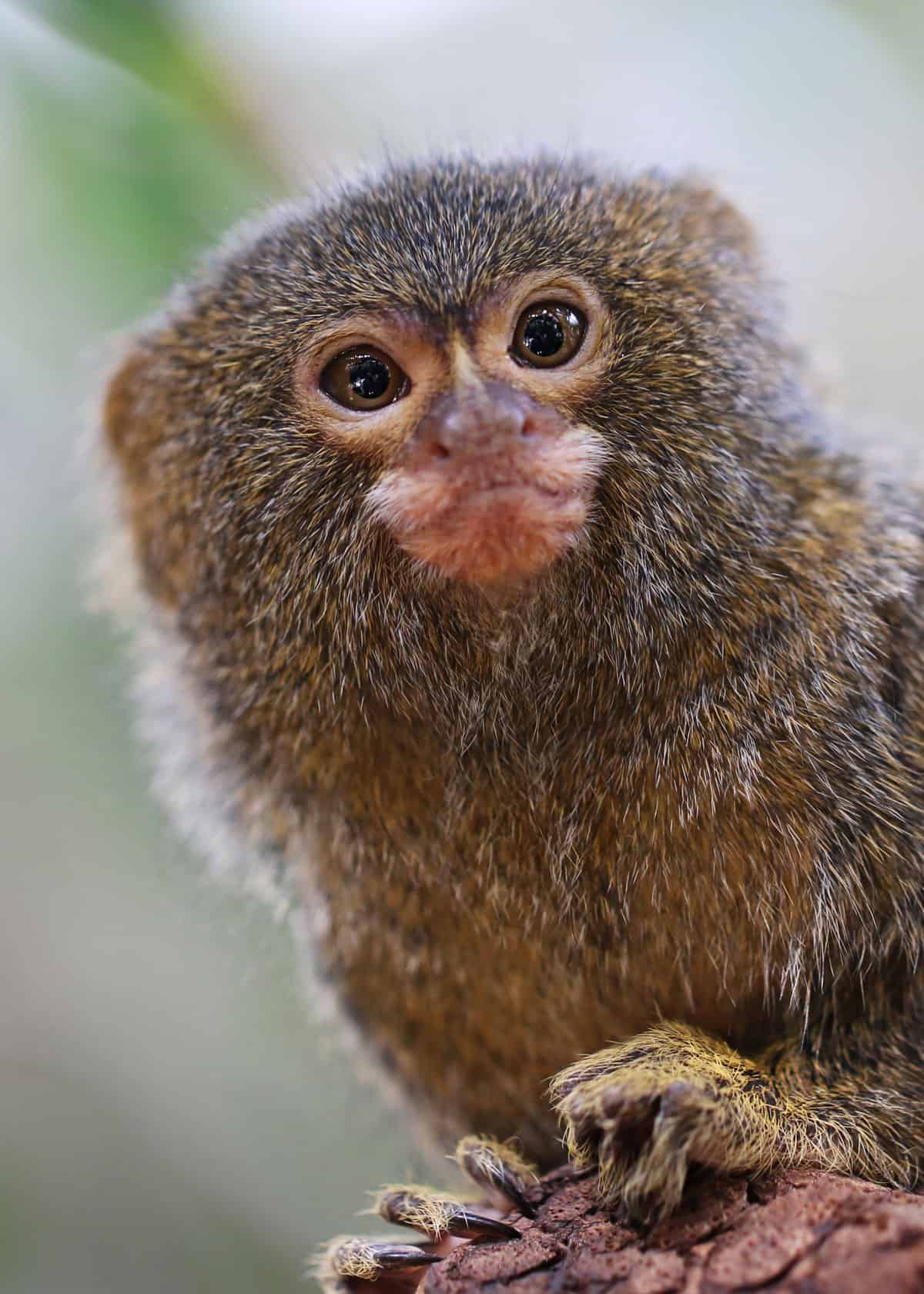
6. Is the pygmy marmoset the smallest monkey in the world?
Yes. While not the smallest primates in the world, pygmy marmosets are definitely the smallest monkeys in the world. They’re even smaller than other members of the marmoset family.
7. What is the world’s smallest primate?
The tiniest primate in the world is something known as the mouse lemur. Measuring just 3 – 4 inches and weighing around 1.1 ounces, it’s so minuscule that you can cup your entire palm over it.
However, it should be noted that mouse lemurs are quite different from pygmy marmosets. Monkeys and lemurs are entirely separate species.
8. Where can pygmy marmosets be found?
Pygmy marmosets are common sights in zoos, nature reserves, national parks and “exotic” pet stores, so they can be found all around the world as domesticated animals.
When it comes to wild pygmy marmosets, however, you’ll need to go to South America to see them. Their natural habitat is scattered around the Amazon Basin. This includes Peru, Ecuador, Colombia, Brazil and Bolivia.
9. What is the pygmy marmoset habitat?
Pygmy marmosets live in trees. Their favorite place is the rainforest, but they’ll also make do with tree-lined rivers, swamps and streams. They like anything with bushes, branches, vines or groves where they can forage for food and hide from predators.
They typically stay in the lower levels of tree cover. They don’t like to go to the very top of the canopy, so they’ll stop climbing around 60 – 70 feet high. This protects them from birds of prey (like Harpy eagles) while still giving them plenty of access to food sources.
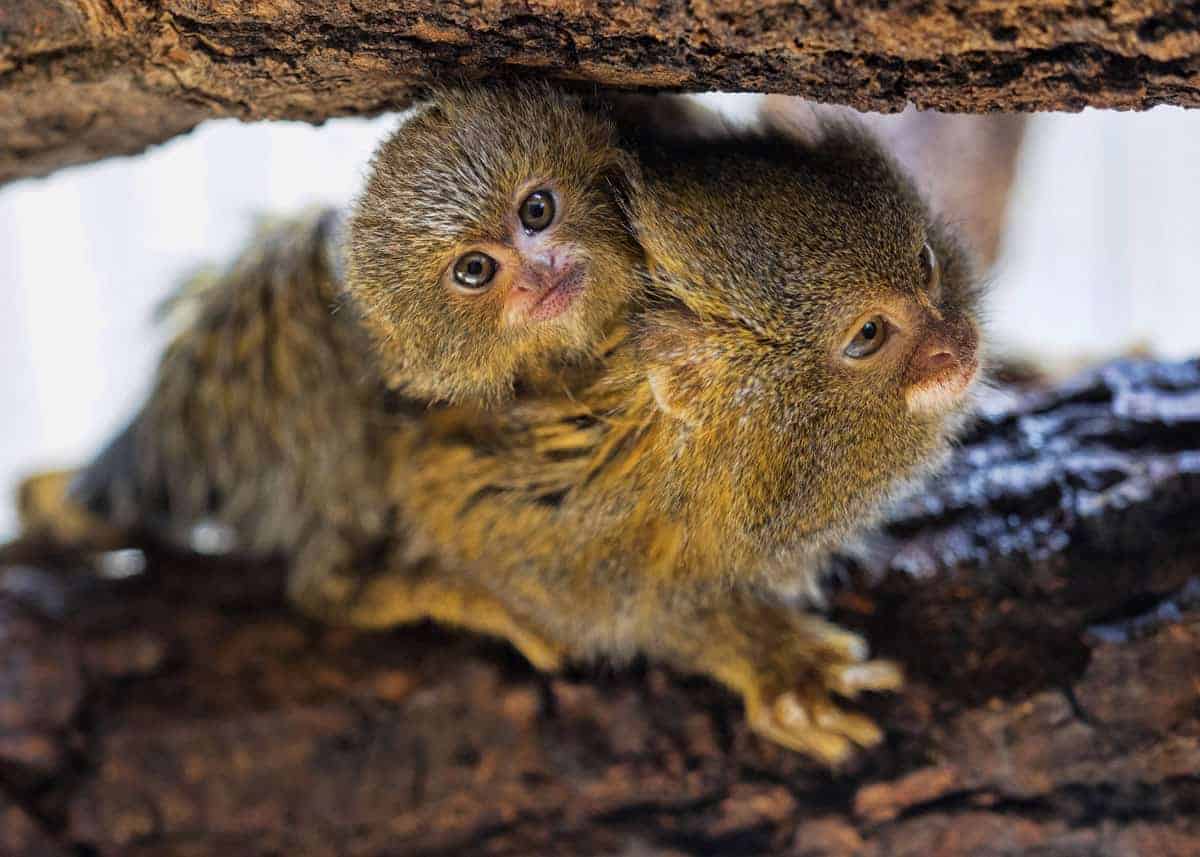
10. Are pygmy marmosets agile?
Pygmy marmosets are incredibly fast and flexible. They’re quite mobile, using all four legs to climb up trees and cling to branches, and they can leap 15 feet in a single bound.
They can also swivel their heads 180 degrees, and this helps them to detect and evade predators very quickly.
11. What does a finger monkey look like?
Their size might be the most eye-catching thing about them, but finger monkeys have other cool characteristics as well.
Their fur is very bristly and bushy, and it stands out from their head a bit like a lion’s mane. They also have unusual colors streaked across their chests and backs. While their primary colors are brown, black, beige and gray, there are often yellow or white splotches that dot them in distinct and unique shapes.
Another fun feature of pygmy marmosets is their striped tail. It doesn’t occur in every animal, but it’s common, and these black or bronze bands can add more color to their palette.
12. What do pygmy marmosets eat?
You’re probably familiar with carnivores and herbivores, but have you ever heard of gummivores? These animals subside on the gum and sap of trees. Pygmy marmosets are gummivores: they use their long, sharp claws for digging into tree bark and creating little holes to gather sap.
It’s a slow process, and they often leave their holes and return at a later date to collect whatever has welled up. Their tongues and teeth are used to help them “harvest” it. They have special incisors that can pierce vines, branches and tree trunks when their claws fail.
In addition to gum and sap, pygmy marmosets will also eat fruits and insects. They’re particularly dangerous to butterflies. When butterflies are attracted to the smell of sap, pygmy marmosets will grab them out of the air and enjoy a snack.
13. What are the pygmy marmoset subspecies?
Until very recently, it was assumed that all pygmy marmosets were the same. It surprised a lot of researchers when genetic testing revealed that there were actually two distinct subspecies:
- Cebuella pygmaea pygmaea
- Cebuella pygmaea niveiventris
The first is found in the north and west of the Amazon Basin; the latter is found in the east. There’s no real visible difference between them except for their genes.
14. What do you call a group of pygmy marmosets?
As with all monkeys, a group of pygmy marmosets is called a troop.
15. How many pygmy marmosets live in a troop?
Most pygmy marmosets live in a troop of 2 – 9 individuals. It usually consists of a single male and female with their children, but there might be other adults tagging along as well. After a certain amount of time, both male and female juveniles will break off from their birth troops and leave to establish their own.
Pygmy marmosets are mostly monogamous with male-female pairs devoting themselves to their little family unit. When other males join the group, the female might use them for breeding and child-rearing. When other females join the group, they tend to work together to raise whatever offspring is produced.
It’s rare for multiple females in a troop to be pregnant at the same time. Instead, one female will suppress her reproductive cycle and help the other tend to the young.
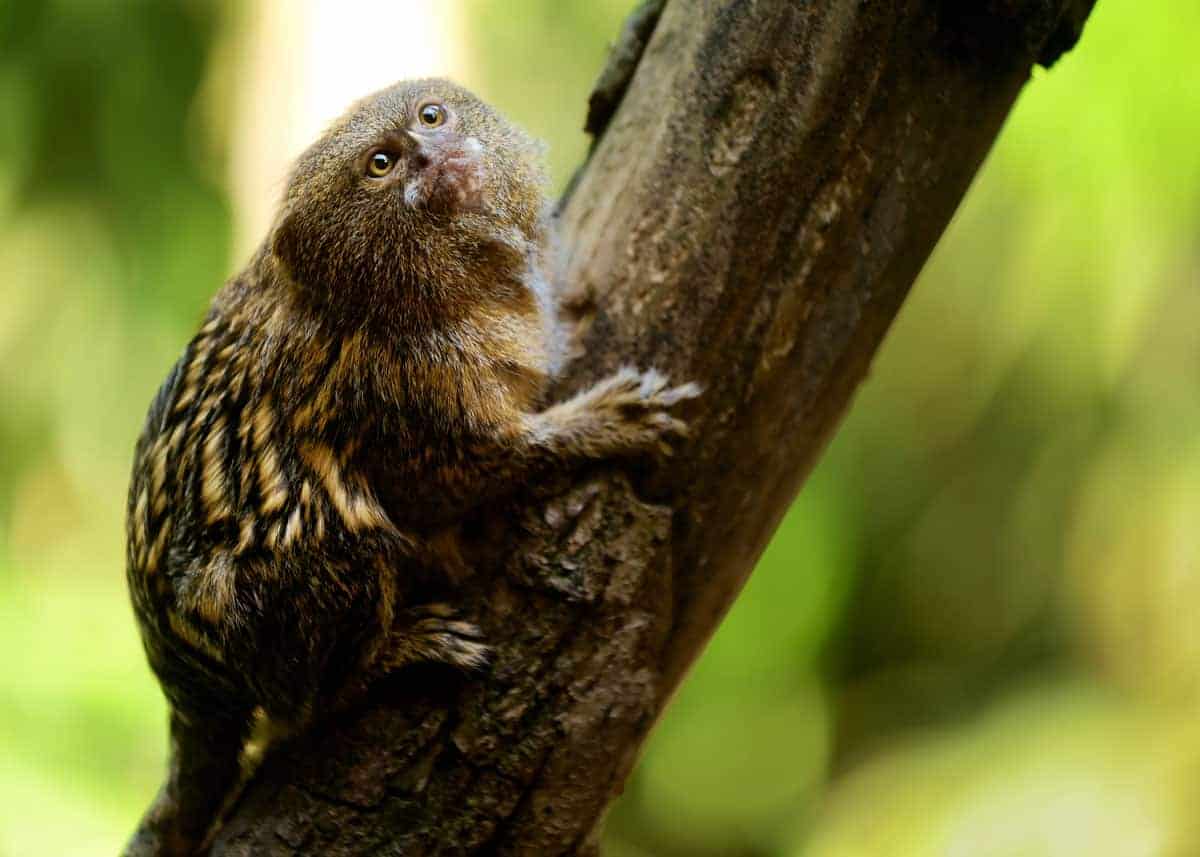
16. Are finger monkeys endangered?
The International Union for Conservation of Nature (IUCN) has pygmy marmosets listed as “least concern,” so they won’t be going extinct any time soon.
However, they do face certain issues in the wild, and it was only recently that their separate sub-species were discovered. This means that their overall population has been split down the middle, so some people are encouraging the IUCN to take another look at their status and make sure that they aren’t in trouble.
17. What threats face the pygmy marmoset?
Habitat loss is a serious issue for many types of South American wildlife. When humans start logging, mining, building and deforesting the land, the animals are driven out of their natural habitats and into other areas where they’re more vulnerable to dangers like starvation and predation.
In the case of pygmy marmosets, they need lots of tree cover to survive, so the destruction of the Amazon rainforest is a pressing concern. They’re losing their home and being scattered into different parts of the continent.
Another threat to pygmy marmosets is the pet trade. While some of them are ethically bred in domesticated settings, others are caught in the wild and forced into captivity. Hunters will also kill mothers to steal their babies, and this can have a ripple effect for their entire troops.
18. Are pygmy marmosets friendly? Are they aggressive?
These are complicated questions.
In the wild, pygmy marmosets can get pretty aggressive. Both males and females are quick to defend their territory or fight each other as part of their mating cycles. Playtime is also rough, and it can have deadly consequences. If a pygmy marmoset falls or gets shoved out of a tree, it can result in their death. Their small bodies simply can’t absorb the impact of the landing.
As pets, however, pygmy marmosets are usually cuddly and sweet. They can become aggressive if they’re hungry, lonely or just plain bored, but without a troop egging on their more boisterous behavior, they tend to be more mellow.
19. How do pygmy marmosets communicate?
Pygmy marmosets have sophisticated ways of communicating with each other. In addition to the usual danger alarms when a predator is near, they also have trills and contact calls to keep in touch when they’re traveling through different trees. These calls have been extensively studied by researchers since they have various volumes, frequencies and meanings.
Another fun feature of the species is the fact that infants “babble” to teach themselves how to vocalize. It’s just like human babies playing around with different sounds before they start to speak real words. Parents and siblings encourage this communication by babbling back.
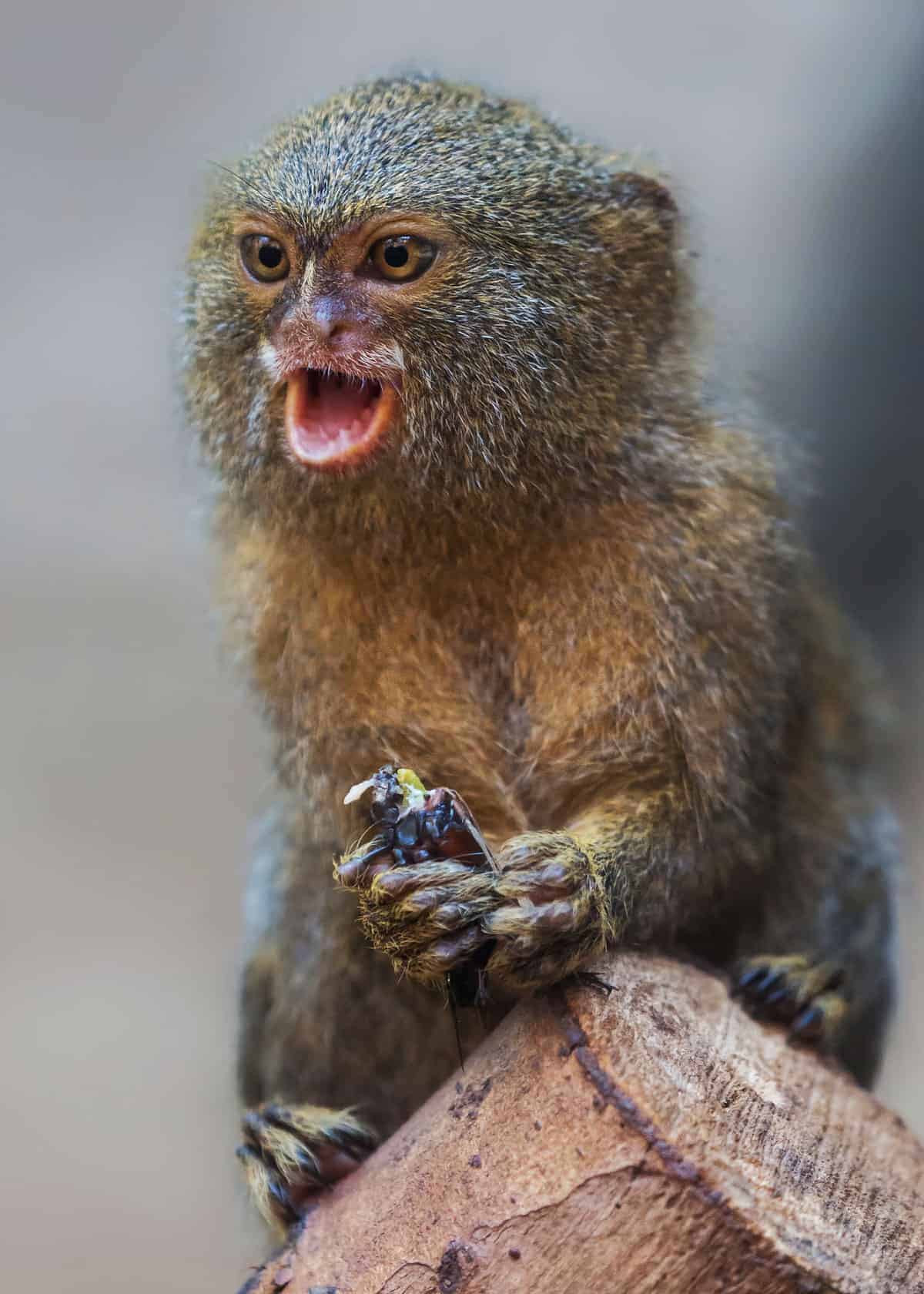
20. Do pygmy marmosets use scent trails?
Yes. It’s common for monkeys to communicate by scent as well as sound, and pygmy marmosets are no exception.
They have scent glands on their chests and privates for this very reason: The chemical signals will let others know where to follow a trail or when a female is ovulating.
21. How do pygmy marmosets reproduce?
Pygmy marmosets have some pretty unique habits when it’s time to bear and raise children.
For starters, the moms will nearly always give birth to twins. They might occasionally have a single child or a set of triplets, but twins are by far the most common.
The whole family is involved with child-rearing. Males will stick close to pregnant females to protect them from danger and provide sustenance. Once the babies are born, the proud new dads will assist the moms in carrying them around.
Any siblings in the troop are expected to play their part, too. They look after the babies and show them how to jump, explore, groom themselves, forage for food and balance on tree branches. It’s thought that this kind of interaction helps the siblings learn how to care for infants before they break off and start their own families.
22. What are baby pygmy marmosets like?
Baby pygmy marmosets are born with a certain amount of independence right off the bat. Unlike other species, they aren’t blind, hairless or helpless. They’re generally able to see and move as soon as they get their bearings as a newborn.
Since they can’t jump, however, babies are usually carried on the backs of their parents for a good 2 – 3 weeks after they’re born. Once they reach a certain size, their parents will start to leave them alone in a secure area while the rest of the family looks for food.
This “baby parking” is quite unusual for primates, but it might have something to do with the fluid and flexible nature of the pygmy marmoset species.
They move around a lot, and it’s tiring for mom and dad to carry growing babies everywhere, so they might have developed the habit of leaving them alone to increase everyone’s odds of survival.
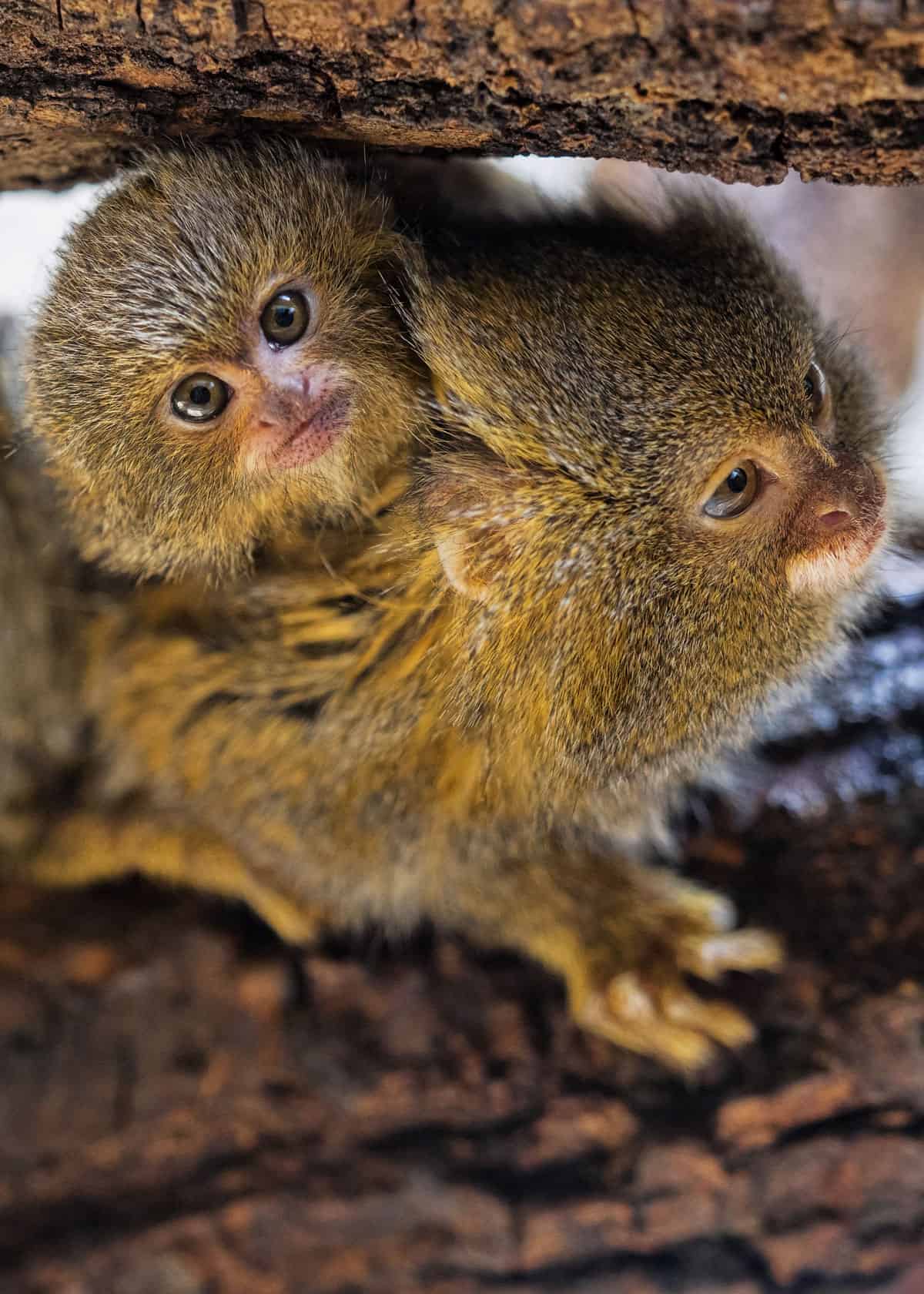
23. How many pygmy marmosets survive to adulthood?
According to nature studies, about 67 percent of pygmy marmosets make it to adulthood. This isn’t a terrible number for wild animals.
The biggest risk factor for infants is being killed by a predator when they’re too young to run or leap away, but they can also suffer falls from trees or injuries from learning how to jump.
24. How long do young pygmy marmosets stay with their troops?
There’s no exact age when pygmy marmosets decide to leave home.
It’s usually after 2 – 3 birth cycles from their mother, but since female pygmy marmosets can get pregnant at any time of year, there’s no definitive mating season or maturation age that marks the end of their adolescence.
If mom feels like her troop is getting too large, she might start to behave aggressively towards her oldest children to shoo them away.
25. Do pygmy marmosets have opposable thumbs?
No. As New World monkeys, pygmy marmosets aren’t born with opposable thumbs. They only use their fingers for things like climbing and gripping.
26. How do pygmy marmosets defend themselves?
Pygmy marmosets don’t have many defensive tactics. They often freeze when a predator approaches in hopes that they aren’t noticed.
Sometimes, if they see the predator from far away, pygmy marmosets will call out to their troop and dash deep into the trees for cover. This is where their advanced communication system comes in handy. They can send out specific calls depending on the type of danger that’s coming.
Occasionally, a troop will work together to scare off a predatory or trespassing animal. This usually only happens with large troops and small intruders. The pygmy marmosets will surround it, screech loud sounds at it and attack it with projectiles until the animal is driven away.
27. Are pygmy marmosets considered a primitive species?
Yes. They might be adorable, but scientifically speaking, pygmy marmosets are much more “primitive” than some other monkey species. They don’t have opposable thumbs; they don’t have prehensile tails. They’re also born with claws instead of nails.
All of these things classify them as a “primitive” species of monkey.
28. Are pygmy marmosets nocturnal?
No. Pygmy marmosets make roosts at night in tangles of branches and vines, and they begin their day when the sun rises the next morning.
They usually start by gathering at a tree-hole to enjoy some breakfast sap together, and afterwards, they’ll break off into smaller groups for playing, exploring, grooming and looking for more food.
29. Do pygmy marmosets have any enemies?
Pygmy marmosets are vulnerable to many different predators because of their small stature. They can be snatched by raptors in the trees; they can be caught by lynxes and bobcats on the ground. Climbing snakes (like emerald tree boas) are a particular danger because they can attack unaware marmosets on both high and level ground.
Ants are another problem. While they can’t hurt pygmy marmosets, they can smell the sap from their tree holes and move in overnight while the monkeys are sleeping. When the monkeys wake up, they discover that the ants have overwhelmed their feeding ground, and they have to move on somewhere else.
30. Do pygmy marmosets have any allies?
Pygmy marmosets live in harmony with several other types of monkey, including brown-mantled tamarins. The tamarins like to raid the leftover sap holes of pygmy marmosets.
There’s an occasional scuffle over food when a tamarin picks a sap hole that a pygmy marmoset wasn’t quite finished with, but generally speaking, they tolerate each other and will react to the same calls when danger is near.
 31. Are Fingerlings based on pygmy marmosets?
31. Are Fingerlings based on pygmy marmosets?
Yep! If you were around for the Fingerling craze of the 2017 holiday season, you probably remember these colorful animal-shaped toys that could wrap around your finger.
They were based on pygmy marmosets, but the product line also included sloths, pandas, dragons and unicorns.
Finger Monkeys as Pets: 9 Questions Answered
They’re definitely on the “exotic” end of the pet scale, but if you’d like to own a pygmy marmoset, you can make it happen. There are just a few things that you’ll need to know before you whip out your credit card.
1. Is it legal to own a pygmy marmoset as a pet?
It depends on where you live. It’s illegal in many parts of Canada; it’s allowed in many parts of the UK.
In the United States, it’s determined by individual states. Some freely allow the private purchase of monkeys; others will require you to obtain a permit first; others still completely prohibit it.
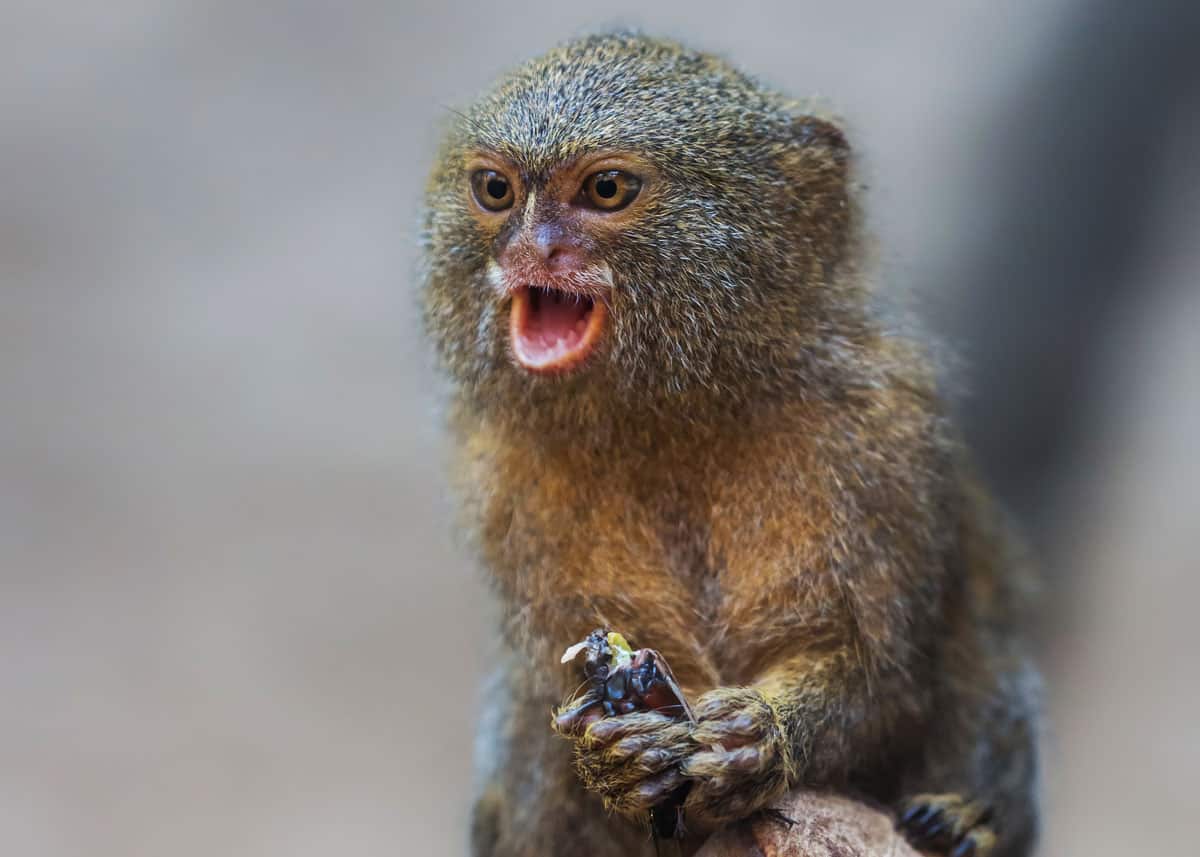
2. Do pygmy marmosets make good pets?
Pygmy marmosets can be cute, cuddly pets who will munch on their favorite foods while curled around your finger like a tree branch.
They can also be terrors who make loud noises throughout the night and fling feces at you. Your experience with a pygmy marmoset will depend on how well that you take care of it!
3. Are pygmy marmosets aggressive or badly-behaved?
Away from their troops and the predators of the wild, pygmy marmosets aren’t particularly aggressive. However, they can get destructive if you don’t provide them with enough entertainment.
This isn’t an animal that you can ignore for long stretches of time; once you bring it home, you’ve committed yourself to spending several hours per day on its feeding, bathing, exercising and socializing.
4. What kind of environment do you need for a pygmy marmoset?
The easiest way to contain your finger monkey is with a cage. It should be big enough to allow uninhibited movement, and it should have plenty of swings, toys and fake tree branches to keep your monkey occupied.
Another important thing for finger monkeys is sunlight. If it isn’t possible to put their cage by a window, you might want to invest in an ultraviolet lamp. Finger monkeys are used to sleeping in the dark and rising with the sun, so you’ll need to simulate this kind of environment to keep their circadian rhythms intact.
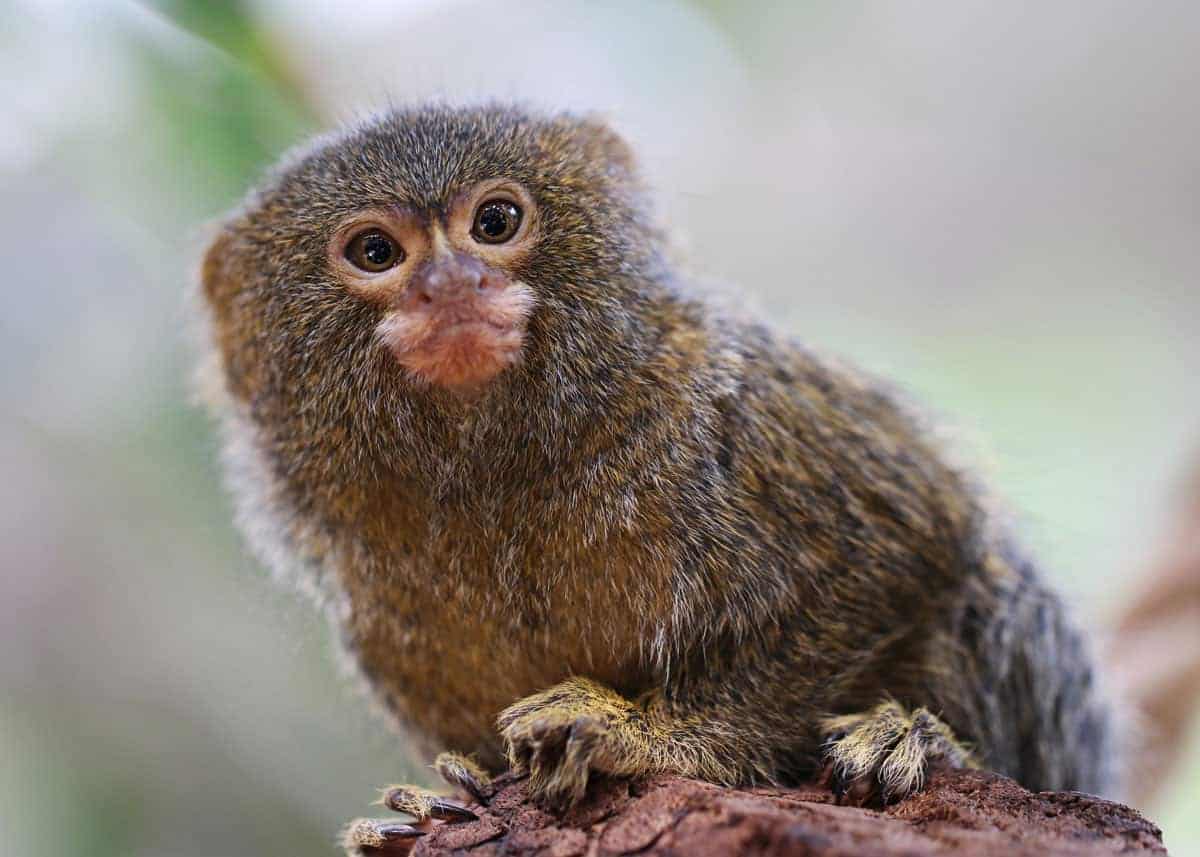
5. Do pygmy marmosets stink?
There’s no inherent odor to pygmy marmosets themselves, but their urine can be rather strong-smelling.
Some owners combat this by putting their monkeys in tiny diapers, but you should know that they’ll need frequent changing to keep the animal from getting a rash. It might be easier to just let them do their business as they will and clean up their cage as soon as it starts to smell.
6. How much do finger monkeys cost?
Finger monkeys aren’t cheap. You should expect to pay anywhere between $1,000 – $4,000 for these pint-sized primates, and this isn’t including things like food, bedding, toys and other pet purchases.
Why are finger monkeys so expensive? It’s mostly due to their rare and exotic nature. They’re much more difficult to breed than an everyday cat or dog, and with the restrictions on capturing them in the wild, that leaves a high demand with a minimal supply. Prices are at a premium because of it.
7. How long do marmoset monkeys live?
Barring complications, you can expect your pygmy marmoset to live anywhere between 10 – 20 years. Better care means a longer lifespan.
8. What happens when a finger monkey gets sick?
It can be tricky when a finger monkey comes down with something. Most vets lack experience with primates, and many of them will turn you away.
You might have to find a primate specialist, and as with many things about pygmy marmoset care, it won’t be cheap.
9. Should you buy an adult or baby monkey as a pet?
There are pros and cons to each type of pygmy marmoset. If you buy an infant, you can train it much more easily than if you buy an adult with deep-rooted habits and attitudes.
On the flip side, baby pygmy marmosets need to be fed every two hours for their first few weeks of life, so they’re a big time sink. Ultimately, it’s up to you.
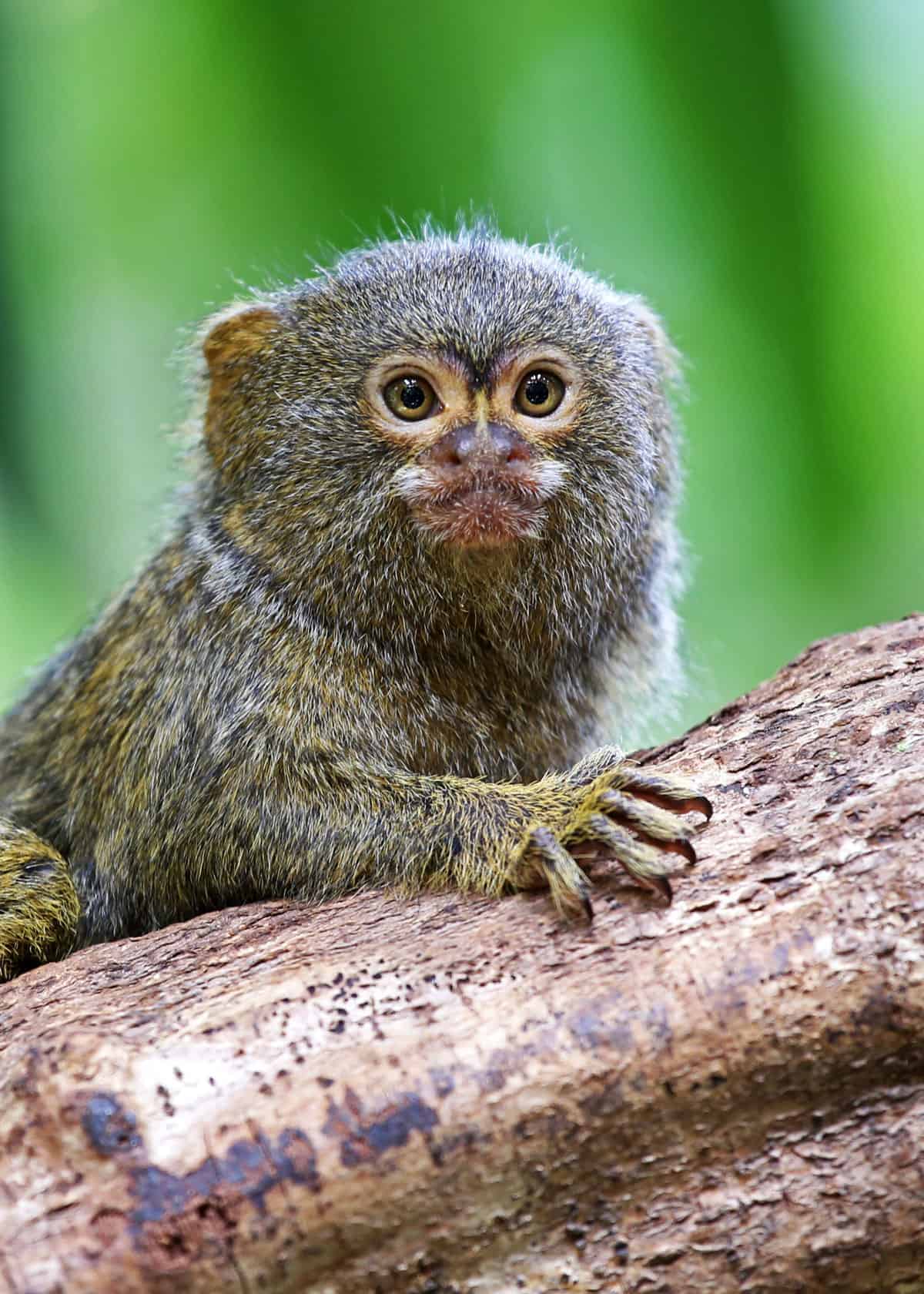
More reading: Guide to Amazon Rainforest Animals
Pygmy Marmosets: The Bottom Line
They’re tiny. They’re colorful. They defy many expectations of the typical monkey. Pygmy marmosets are definitely one of a kind, so we hope you’ve enjoyed learning these pygmy marmoset facts and educating yourself on some of nature’s smallest primates!
Have you seen these before? Maybe in the zoo or even in the wild? Have a question or fact to share? Join me in the comments!







can all pygmy marmosets look different?
-Thanks
Pygmy Marmosets belong in the wild! Keeping them as pets is harmful to them. They need their troops, they are even monogamous. Separating them from their mates and babies causes them great distress. Please consider that before you decide to bring one home!
Are Pygmy Marmosets taken from their mother immediately after birth, or are they waned at a certain age?
Very interested in considering one as a pet for myself. Cost isn’t an issue, I just want one from a very reliable, reputable breeder who only breeds for the love of the species and not for the money. I welcome any contact information for exceptional breeders!
Please feel free to relay the information to me by text at 251-213-3934, or email at Basshooker831@gmail.com with “Top Marmoset Breeder” in the subject line. Thank you in advance for any referrals, and also your valuable time and knowledge on this matter!
Sincerely,
Tammy Lewis-Johnson
I enjoyed the informative article about the Pygmy Marmosets. Two questions:
Is it legal to have them as pets in Cuenca, Ecuador (where I live)?
Can you advise me of a source for obtaining them here in Ecuador?
Thanks!
I enjoyed your article on pygmy marmosets. Is it legal to keep them in Ecuador? Do you have information on where they can be bought in Ecuador? Thank you!